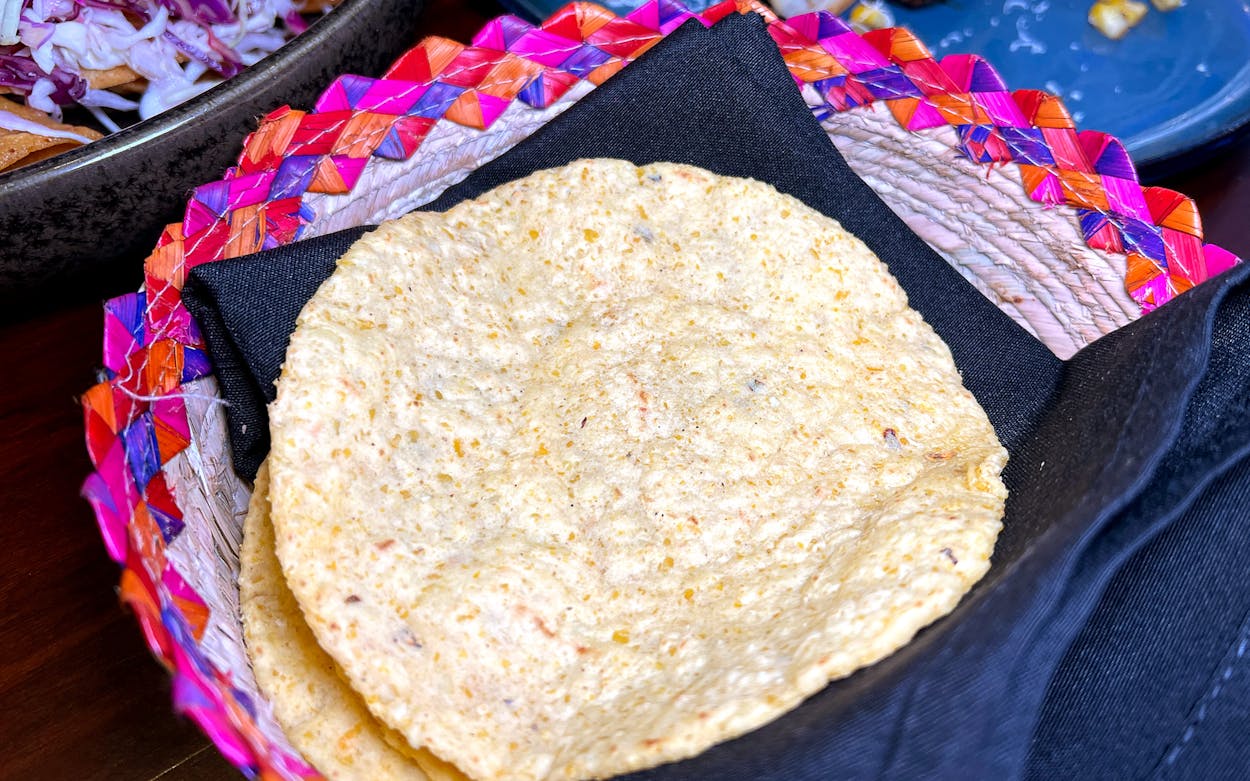Imagine a burger recipe whose ingredient list calls for a “bun.” Then, once the burger is assembled, the “bun” holding the patty, toppings, and sauces disintegrates, tears, or breaks down. The cook would be distraught and probably hungry. Would the dish have been more edible if the writer had specified a potato bun, pretzel bun, brioche bun, or King’s Hawaiian roll instead of just a “bun”?
Like a muffuletta must be on a focaccia-like, sesame-topped loaf; a jambon beurre isn’t possible without a baguette; and a patty melt requires rye bread, different Mexican dishes require specific tortillas. So why do many recipe writers forgo that?
A thoughtfully selected or prepared tortilla makes the difference between a mediocre taco and an incredible one. I’ve written about this topic many times, often noting in my reviews whether the tortilla is nixtamalized, made in-house from masa harina, or ordered from a commodity purveyor, and describing its flavor and texture. The tortilla’s importance is widely acknowledged by diners and cooks, but recipes often treat it as a generic vessel. It’s not.
Corn tortillas differ in taste and texture, depending on the corn used—and I’m not just referring to yellow or white. There’s herbaceous cónico azul and nutty bolita belatove, just to provide a couple of examples. Flour tortillas vary regionally. There are wide, flaky Brownsville tortillas, fluffy San Antonio tortillas, and gauzy Sonoran tortillas, to name a few.
When a recipe just asks for a “tortilla,” home cooks will probably acquire the desiccated discs in colorful packaging stocked on most mega-grocer shelves. But a delicious variety of tortillas are available if cooks take an extra step while shopping and recipe writers take the time to educate their readers.
Victoria Elizondo, owner and executive chef of Cochinita & Co., in Houston, thinks these details are critical. “I grew up eating barbacoa [tacos] on flour. If I wanted them Tlaquepaque style, then I would have them on corn,” Elizondo says, referring to the preparation smothered in a coffee-colored salsa. “You shouldn’t just throw anything on whatever,” she adds. Elizondo includes instructions for homemade tortillas in her own cookbook, Taco-Tastic: Over 60 Recipes to Make Taco Tuesdays Last All Week Long, as more cookbooks should.
But if a cook isn’t keen on hand-making tortillas, it can be harder to know where to shop for decent variety. Elizondo likes her burritos on Sonoran-style—wide, thin, tensile, nearly translucent—flour tortillas. “Let’s be honest, where are you going to find those?” Elizondo asks. She purchased some by New Jersey–based Vista Hermosa at her local Central Market. “They’re delicious, but they’re six inches,” she noted. “You can’t make a burrito out of that.”
Luckily, there are myriad tortillerias across the state that can help, including Sanitary Tortilla Company in San Antonio, Mrs. Rios Corn Products in San Angelo, La Colonial Tortilla Factory in El Paso, and Molino Olōylō in Dallas. Some focus on specific offerings: La Norteña Tortillas, in Dallas, for example, specializes in Sonoran-style flour tortillas and ships its products. Other businesses also have e-commerce operations, so it’s not that hard to source tortillas, especially in Texas.
“Ideally, you serve this [taco] on a San Antonio–style puffy flour tortilla or you should be serving tacos al carbon on really large, heavy South Texas tortillas,” says cookbook author Lisa Fain (a.k.a. the Homesick Texan). “It’s a package. I think being specific is important.” In her cookbooks, she explains the style and regional home of each dish and its components, such as tortillas. But she isn’t draconian about how home cooks proceed from there. “As a recipe writer, you can say, ‘Okay, this is a Brownsville taco and we want this,’ but I’m not going to be upset if someone doesn’t do that,” she says.
Ali Khan, a food writer and Cooking Channel host and judge, recently wrote an article about the smash-burger (or Big Mac–taco) trend. He made them at home several different ways, and found a thick, house-made corn tortilla works best. “Makes me happy when I put in that work,” he says. “And I think other people should appreciate it.” He agrees other writers and food publications should follow suit. “Can we please take the time to recognize there are better ingredients out there?” he added.
You might argue recipes are already laborious and time-consuming, and adding an extra step or a hard-to-find ingredient is a bridge too far. But what you lose is much greater—the amazing variety, taste, color, and texture Mexican cuisine has to offer.








